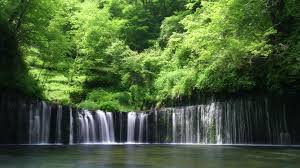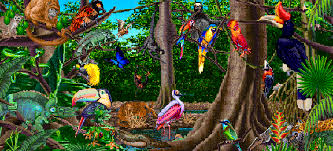Sloth
Sloths are extremely slow-moving mammals found in the rainforest canopies of Central and South America. There are two species of sloths:two-toed and three-toed. Most sloths are about the size of a small dog and they have short, flat flat heads. Their hair is grayish brown but, at times they look grey-green in color because they move so slowly that tiny camouflaging algae grow all over their coats.Some sloths stay in the same tree for years. Their huge hooked claws and long arms allow them to spend most of their time hanging upside-down from trees. Since they have a slow metabolism, they need very little food. They feed on fruit, leaves, buds, and young twigs. Sloths also sleep upside-down for up to 18 hours at a time. Mothers also give birth to babies upside-down. Babies cling to their mothers until they are able to take care of themselves.Sloths are nocturnal and sleep curled up with their head placed between the arms and the feet drawn close together. This disguises them as part of a tree so that its enemies like the jaguar do not see them. Sloths rarely climb down from the trees and can live for up to 30 years.
Spider Monkeys
Spider monkeys are large in size. Adult monkeys grow to be almost two feet tall excluding the tail. They have a powerful tail that they use as an extra limb. Spider monkeys like to hang upside-down with all four limbs and the tail holding on to branches which makes them look like a spider and thus their name. They also have the ability to swing from branch to branch at a high speed. Their fur color can be black, brown, golden, red, or tan.Spider monkeys spend most of their time high up in the canopy where they can find fruits and seeds to eat. They also eat plants. They are unusual monkeys in that they have only four fingers and no thumb. Spider monkeys are heavily hunted and are in danger of becoming extinct.

Macaws are the largest of all parrots. There are 16 different species of macaws and they range in size from a little over three feet to one foot. They have beautiful, graceful, tails that are as long or longer than their bodies. They also have long, pointed wings that enable them to fly swiftly.Macaws have sharp, hooked bills which are perfect for eating nuts, fruits, and seeds. The beak is strong and is used to break open nut pods. Their feet have a very strong grip which allow them to grasp easily. Two of their toes point forward and two point backward. They can use their foot to grasp food and bring it to their mouth.Macaws are very social and intelligent animals. They can be found in Central and South America in the canopy and emergent layers of the rainforest. They like to nest in holes in trees. Macaws are on the endangered species list because their numbers are declining due to rainforest destruction and people capturing them for pets.
Toucan 
There are about 40 different kinds of toucans. They vary in size from about 7 inches to a little over two feet. They have short and thick necks. Toucans are distinguished by large, colorful, yet lightweight bills. The color of the bill may be black, blue, brown, green, red, white, yellow or a combination of colors. The bright colors on his bill help to attract a mate. Toucans also have a narrow, feather-like tongue. They can be noisy birds with their calls sounding harsh and raspy.A toucan’s bill is sharp and has saw-like edges. The bill is used to squash the many kinds of fruit and berries he eats. He may also use the saw-like edges to tear off parts of larger fruits. Also included in their diet are small birds and lizards. Toucans make their homes in holes in trees. They usually live in pairs or small flocks. White, glossy eggs are laid once a year and when they hatch, the new chicks have no down covering them.Toucans are found in South and Central America in the canopy layer of the rainforest. When they sleep, they turn thier heads around and tuck their bills under their wings and tail. The toucan is very important to the rainforest because they help to disperse seeds from the fruits and berries they eat.
Poison-arrow frogs
Poison-arrow frogs are social frogs found in Central and South America. They are known by their bright colors which warn other animals that they are poisonous. Its poison is one of the most powerful known and can cause paralysis or death. It is so potent that one millionth of an ounce can kill a dog and an amount smaller than a grain of salt can kill a human. One frog carries enough poison to kill about 100 people. Native hunters use it on the tips of their arrows which is how the frog got its name.
Poison-arrow frogs are about the size of a man’s thumbnail (less than one inch). The tiny frogs lay their eggs on leaves. When the tadpole hatches, it is carried on one of the parents’ back to a bromeliad where the parents feed it small insects, ants, spiders, crustaceans, and tiny water animals. The mother frog may also lay infertile eggs as food for the tadpoles.
Poison-arrow frogs are beautiful to look at. Their colors vary from red to yellow to blue. The enemies they encounter are large animals (including humans) who may step on them. Though poison-arrow frogs carry a deadly poison, they are usually harmless if left alone.
Thank you for reading 🙂




